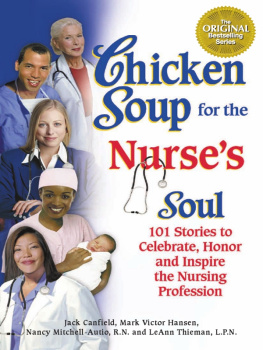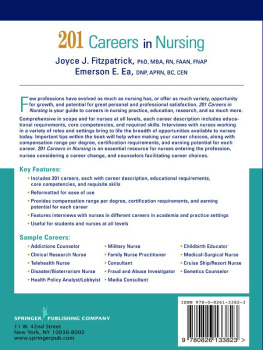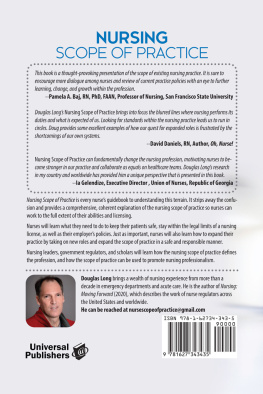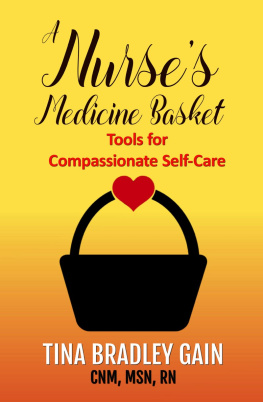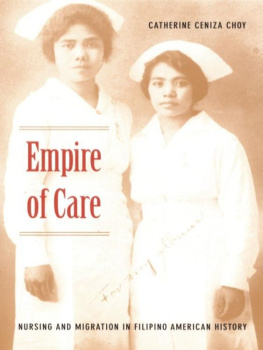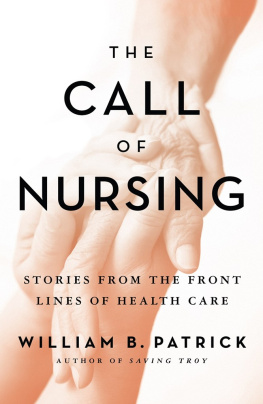Published by The History Press
Charleston, SC
www.historypress.net
Copyright 2016 by Valerie Hart, Susan Henderson, Juliana LHeureux and Ann Sossong
All rights reserved
First published 2016
e-book edition 2016
ISBN 978.1.62585.822.1
Library of Congress Control Number: 2015959412
print edition ISBN 978.1.46713.539.9
Notice: The information in this book is true and complete to the best of our knowledge. It is offered without guarantee on the part of the authors or The History Press. The authors and The History Press disclaim all liability in connection with the use of this book.
All rights reserved. No part of this book may be reproduced or transmitted in any form whatsoever without prior written permission from the publisher except in the case of brief quotations embodied in critical articles and reviews.
ACKNOWLEDGEMENTS
This book is dedicated to Maine nurses. In 1914, Maine nurses formed a professional association, and in 1915 they successfully advocated for legislation requiring the registration of all Maine nurses. These actions were taken to provide for standards of nursing education to promote quality nursing care. This book identifies the caring and competence of Maine nurses from this beginning in 1914 to the present, 2015.
We would like to acknowledge the research and publications of Marla Davis, MS, RN, and Martha Eastman, PhD, MS, BS, CMC, and thank them for their contributions. We acknowledge the dedication and expertise of Beth Clark, PhD, RN, in developing this book. We thank Myra Broadway, JD, MS, RN, for her editorial contributions, support and promotion of the centennial of the American Nurses Association (ANA) coming to Maine and the formation of the Maine State Board of Nursing.
We are grateful to all those who were willing to be interviewed and to those who conducted the interviews, especially students at the University of Maine and Husson University, as well as faculty member Jeanne-Ann Ouellette. We thank the talented transcriptionists, Shawn Plante, Ruth Elkin and Wendy Ledger, and those who offered to read and provide feedback on a work in progress, Millicent Higgins, Charmaine Daniels, Ellen Bridge, Leslie Nicoll and John Clark. We would also like to thank Abigail Wellman for her work on preparing our photographs and all those who shared their photographs.
Thank you to the Maine Folklife Center, University of Maine, for archiving our oral histories. We thank ANA Maine, Kappa Zeta-at-Large, Omicron Xi Chapter-at-Large and the Maine Nursing Practice Consortium, all of which gave us gifts of financial support.
Susan Henderson, Myra Broadway, Ann Sossong and Julie LHeureux at the Maine State Board of Nursing developing Maine Nursing. Courtesy of Juliana LHeureux.
All royalties from sales of this book go to the American Nurses Foundation for the purpose of supporting Maine nursing research.
We particularly thank our editor, Mary Pelletier, MS, BS, RN, who donated her time, expertise and energy over more than two years to provide content and copy editing and support.
INTRODUCTION
Nurses are ordinary people who do extraordinary things; their recollections reveal this. Maine Nursing: Interviews and History on Caring and Competence is a collection of oral histories that document and preserve the wisdom and memories of nurses. Student nurses were the primary collectors of these oral histories. Dr. Ann Sossong and Dr. Beth Clark at the University of MaineOrono had their students collect oral histories of Maine nurses as part of a course to appreciate components of leadership and to consider how past events and developments influenced the future of the nursing profession. As the centennials of the Maine State Nurses Association (2014) and the Maine State Board of Nursing (2015) approached, others joined in interviewing nurses with the goal of using their stories to write a book honoring Maine nurses and their contributions to society.
This book contains selected stories of Maines nursing heroes. There were many nurses who were never interviewed. There were many more interviews of nurses who made significant contributions that were not included. Many stories were not used in their entirety, and only portions of peoples accomplishments have been included. These few stories are intended to honor all nurses and are tributes to Maines past nurses and leaders whose expert and compassionate care guide our path into the future.
As early as 1797, Marguerite-Blanche Thibodeau Cyr, affectionately known as Tante Blanche, provided care for the French settlers in
A statue of the Gray Nuns, Sisters of Charity, Saint Marys Hospital. Courtesy of Saint Marys Medical Center.
Madawaska in northern Maine during the black famine and was recognized as the savior of her people. At that time, Cyr instinctively employed public health techniques when she inventoried and allocated scarce food provisions in the community and redistributed supplies according to need. Many women participated in building compassionate care before the development of professional nursing. Their work became the foundation of nursing practices that the public recognized as the basis for the most trusted profession.
Vintage portrait of a Maine General nurse, Portland. Courtesy of Maine Medical Center (MMC).
Ward A, Maine General, Portland, early 1900s. Courtesy of MMC.
Chapter 1
BUILDING FOUNDATIONS OF A PROFESSION
19141919
Nursing care was based on compassion, justice and social reform by early nursing leaders. The period from 1890 to 1920 was known as the Progressive Era, during which political and social reforms were needed to serve growing populations and diverse communities. As the Industrial Revolution intensified, Americans moved from farms into cities to work in factories, and immigration increased. Conditions in tenements around factories were overcrowded. Factory workers, including children, often toiled long hours in unsafe workplaces. In the urban areas, unhealthy conditions and lack of support systems resulted in the need for more care to be provided in institutions.
For most of the 1800s, hospitals were unsanitary places staffed with few informed caregivers. Concern about patient safety was the primary goal underlying the adoption of formal nursing in the United States.
As the number of hospital training schools around the nation grew rapidly, problems included lack of program admission standards, exploitation of students as workers and lack of opportunity for adequate clinical education.


